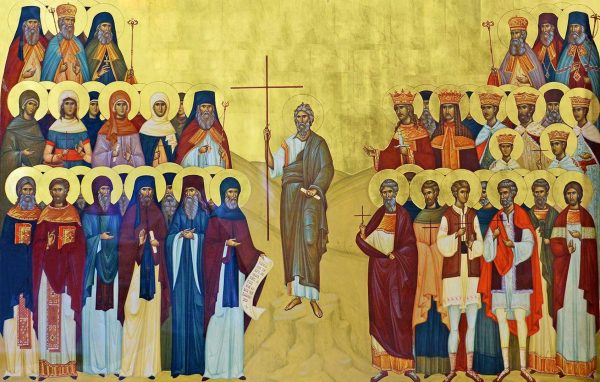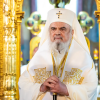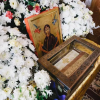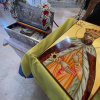The Romanian Orthodox Church, by the decision of the Holy Synod in 1992, set aside the second Sunday after Pentecost as a special day for the commemoration of all Romanian Saints. “The known and the unknown, those who have been canonized and included in the church calendar and those who are not listed and who have suffered in communist prisons fighting for the preservation of the Orthodox faith,” Patriarch Daniel noted last year.
In the context of this holiday, Basilica.ro presented some interesting aspects about the Romanians who are mentioned in the calendar of the Romanian Orthodox Church.
The youngest / oldest martyr
SAINT PHILOTHEA: 12 YEARS OLD
Of Vlach origin, Saint Philothea suffered martyrdom at the age of 12. She was killed by her father because she shared food with the poor. The relics of Saint Philothea are enshrined at Curtea de Argeş Monastery, being brought there during the reign of Prince Radu (Negru) Vodă.
SAINT ATHANASIUS TODORAN: 104 YEARS OLD
The Holy Martyr Athanasius Todoran was martyred at the age of 104. General Bukov, sent by the Court of Vienna to hasten the conversion of Romanians from Transylvania to Catholicism, came to receive the oath of the Nasaud border guards and to be present at the consecration of the flag, being accompanied by a Uniate bishop.
In those difficult moments for Orthodox Christians, when the military was ready to take the oath, “old man Tănase Todoran”, who was then 104 years old, came out on horseback and gave a speech to the Romanian border guards. He persuaded them not to renounce the Orthodox faith.
For this reason, on November 12, 1763, the right-believing Athanasius was broken with the wheel from top to bottom, and his head was tied to a wheel, “because he kept people away from Uniatism and from enlisting in the border military status.”
The first / most recent canonized Saint
THE HOLY HIERARCH CALLINICUS: 1950
Saint Callinicus of Cernica is the first saint canonized by the Romanian Orthodox Church in 1950.
- He was born and raised in Bucharest and had 3 brothers.
- He founded in Râmnic a printing house “Kallinik Rîmnik” which he later donated to the Municipal Council of Râmnicu Vâlcea.
- He founded Frasinei Hermitage, where he laid down the Athonite monastic rule. He built a total of 7 churches and 3 chapels
- He asked the clergy to write and speak only in Romanian.
- He was a lover of literature, he wrote: poems, a chronicle, the history of Cernica Monastery and spiritual guides
- Because he did not amass wealth during his lifetime, St. Callinicus’ will contained only books.
THE HOLY HIERARCH DIONYSIUS: 2018
The last Romanian to make the step from history to the Synaxaria is Saint Dionysius, Bishop of Cetatea Albă and Ismail. The Holy Synod decided to canonize him in 2018 to mark the Centennial of the Great Union. Bishop Dionysius is one of the most outstanding Bessarabian ecclesiastical personalities of the first half of the last century, being one of the fighters for the realization of the Romanian unitary national state.
The canonization proposal came from the Synod (assembly of bishops) of the Metropolis of Bessarabia.
Saint Dionysius:
- At only 15 years old, on November 28, 1883, he entered Suruceni monastery.
- In 1908 he was elected abbot of Suruceni Monastery;
- 80% of the members of the Country Council had the abbot Dionysius as their guide and spiritual father;
- He was ordained to the episcopate in the year of the Great Union (1918);
- He reposed in the Lord in 1943.
In the meeting of February 25, 2021, the Holy Synod decided to prepare the process of canonization of 12 priests and monks for 2025, when the Romanian Orthodox Church celebrates 140 years of autocephaly and 100 years of patriarchal status.
The names announced include Father Dumitru Staniloae, Archimandrite Cleopas Ilie and Archimandrite Gherasim Iscu.
Holy Romanian Polyglots
SAINTS NEAGOE BASARAB and ANDREW ȘAGUNA: 6 FOREIGN LANGUAGES
Saint Neagoe Basarab, the Ruler Prince of Wallachia between 1512 and 1521, knew Romanian (mother tongue), Slavonic, Greek, Latin, Turkish, German, Hungarian.
The Holy Hierarch Andrew Șaguna, Metropolitan of Transylvania (November 30), knew Romanian (mother tongue), Hungarian, German, Greek, Slavonic, Serbian and French.
A candidate for sainthood in 2025, Father Gherasim Icu, knew seven foreign languages.
First martyrs attested on Romanian territory
SAINTS EPICTETUS AND ASTION: JULY 8, 290
They suffered martyrdom during the persecution of the emperor Diocletian (244-311), on July 8, 290. They are the first martyrs of Dobrudja attested by the hagiographic sources.
The martyr’s act dedicated to them has been preserved only in a late copy from the 15th century, located in the Church of the Saviour in Utrecht. It was published in 1615 by the Jesuit scholar Herbert Rosweyde († 1629).
In 1921, the Benedictine Dom Germain Morin discovered in the Hieronymite Martyrology the commemoration of Sts Epictetus and Astion on May 23. “De S.S. Epicteto presbytero et Astione monachu martyribus Almiridensibus in Scythia”, thus strengthening the veracity of what is stated in Acta Sanctorum, edited by N. Rosweyde, mentioned above.
Acta Sanctorum was the source for a study about the two holy martyrs written by the renowned researcher and historian Raymund Netzhammer (1862-1945), who became a Catholic archbishop in Bucharest. He published the book “Epiktet und Astion, diokletianische Martyrer am Danaudelta”, Zug. 1937.
The most modern Saint
SAINT JOHN JACOB OF NEAMT: 1960
A man of prayer, but also a poet, Saint John Jacob of Neamt is an important representative of Orthodoxy, both nationally and internationally. He lived 47 years, intensely, with an unquenchable longing for God, of which 27 years he spent in monasticism.
- He reposed in the Lord in 1960.
- Some lesser-known aspects about St. John Jacob:
- Protector of librarians;
- The first Romanian saint in the calendar of the Greek Orthodox Patriarchate of Jerusalem;
- Holy poet;
- Abbot of the Romanian Hermitage by the River Jordan.
Saints depicted in folk costumes
Among the saints depicted in folk costumes we mention:
- St. Oprea Nicholas;
- St. George the Pilgrim;
- St. Sabbas the Goth;
- St. Philothea;
- The Holy Năsăud Martyrs;
- St. John the Wallachian.

















